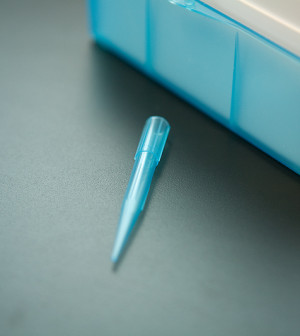- Navigating Your Midlife Crisis: Embracing New Possibilities
- City Raccoons Showing Signs of Domestication
- Mapping the Exposome: Science Broadens Focus to Environmental Disease Triggers
- One Week Less on Social Media Linked to Better Mental Health
- Your Brain Changes in Stages as You Age, Study Finds
- Some Suicide Victims Show No Typical Warning Signs, Study Finds
- ByHeart Formula Faces Lawsuits After Babies Sickened With Botulism
- Switch to Vegan Diet Could Cut Your Greenhouse Gas Emissions in Half
- Regular Bedtime Does Wonders for Blood Pressure
- Dining Alone Could Mean Worse Nutrition for Seniors
Breath Test Might Spot Stomach Cancer Risk


A new breath test may one day help spot the earliest signs of stomach cancer, a small trial from Israel suggests.
This novel technology senses small changes in the levels of particular compounds in exhaled breath, and accurately identifies changes that signal the development of disease, the researchers said. If the findings are confirmed in larger trials, the test might be a noninvasive way to screen those who are at high risk for stomach cancer, they added.
“Our study is based on the hypothesis that detection of precancerous lesions may provide a tool to decrease either cancer deaths or incidence [of stomach cancer],” said lead researcher Hossam Haick, head of the laboratory for nanomaterial-based devices and volatile biomarkers at the Technion — Israel Institute of Technology in Haifa.
Stomach cancer develops in a series of well-defined steps, but there is no effective, reliable and noninvasive screening test for detecting these changes early, Haick said. “Most people are diagnosed when it’s too late to save their lives,” he said.
“Currently, there is no perfect noninvasive tool to screen for stomach cancer,” he said. “Small and inexpensive sensing technology could be developed and used to fulfill these clinical needs.”
The new test uses nanotechnology that analyzes a set of atoms called nanoarrays. In this case, the array includes atoms from breath samples and the computer looks for the amount of specific compounds that are linked to stomach cancer. Nanoarray analysis is accurate, simple and inexpensive, the researchers said.
“A large trial with thousands of patients, including people with stomach cancer or pre-cancer, is now underway in Europe,” Haick noted.
The report was published online April 13 in the journal Gut.
Christine Metz, director of the laboratory of medicinal biochemistry at the Feinstein Institute for Medical Research in Manhasset, N.Y., said, “Stomach cancer is rare in the United States, so it’s difficult to do routine screening knowing that our screening method is endoscopy, which is an invasive test.”
According to the American Cancer Society, about 24,590 cases of stomach cancer will be diagnosed this year in the United States, and some 10,720 people will die from the disease.
Developing a fast, inexpensive and accurate screening test using a patient’s breath is an “amazing improvement,” she said. “It can identify people at risk for stomach cancer who you would want to screen with endoscopy.”
Metz said people at risk for stomach cancer include those with a family history of the disease, the elderly with gastritis, people with a family history of colon cancer, workers in the coal and rubber industries, and people who don’t eat enough fruits and vegetables.
“Early diagnosis is critical for improved survival and [it] clearly lowers health care costs,” Metz said. But before such a test could be widely used, it will have to be validated in thousands of people, she added.
For the study, Haick’s team collected two breath samples from 484 people, 99 of whom had been diagnosed with stomach cancer but had not yet had chemotherapy or radiation treatments. The patients were asked about their smoking and drinking habits and tested for infection with Helicobacter pylori, which is a risk factor for stomach cancer.
The first breath sample was analyzed using a technique that measures the various organic compounds in exhaled breath. The second sample was analyzed using a nanoarray.
The patterns identified using nanoarray technology accurately distinguished the different precancerous stages, identifying patients at low and high risk for developing stomach cancer, the researchers said.
The findings did not change when the researchers took into account age, alcohol use and the use of antacid drugs.
But Dr. David Bernstein, a gastroenterologist at North Shore University Hospital in Manhasset, N.Y., isn’t sure that this new test has a clinical application.
“At this point, I don’t know if this test has any clinical value,” he said. “This is not going to replace an endoscopy and a biopsy. It needs a lot of refinement before one can put this into practice.”
More information
Visit the American Cancer Society for more on stomach cancer.
Source: HealthDay
Copyright © 2025 HealthDay. All rights reserved.










